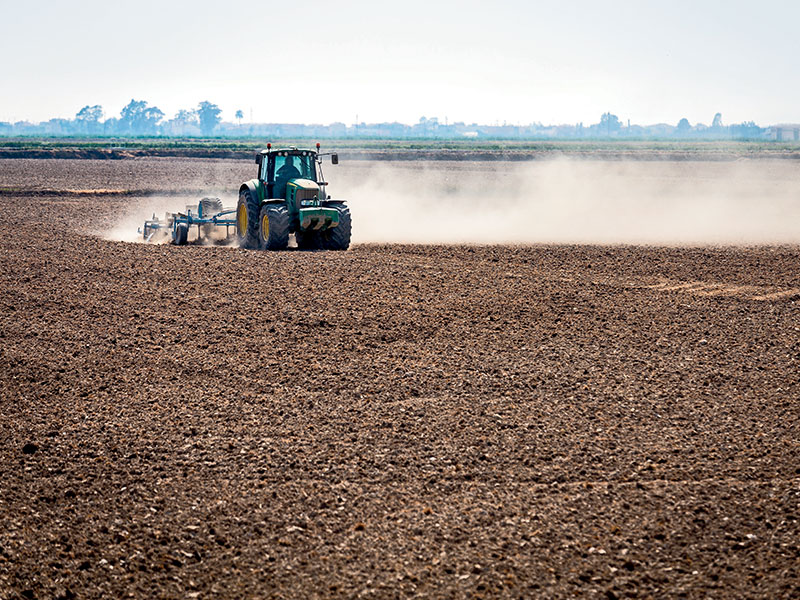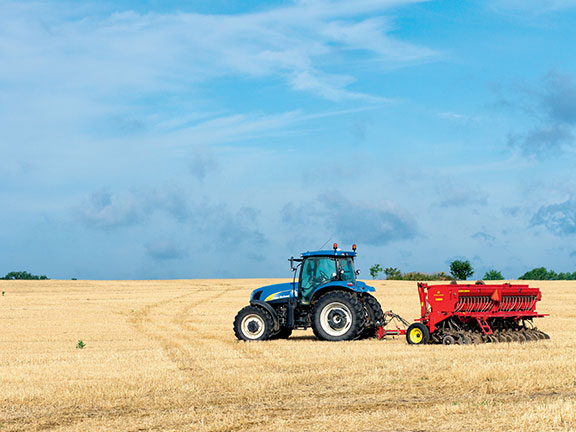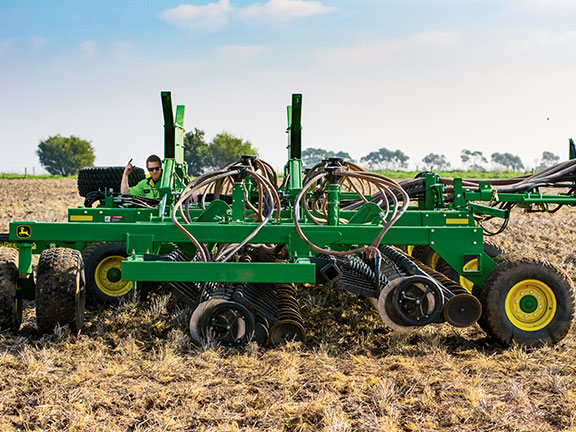Harrison Hunkin investigates why Australian farmers are heading down the path of more holistic conservation agriculture
 |
|
A farmer preparing the land in Ebro delta region, south Catalonia – Photo: Victor Cardoner/Moment/Getty Images
|
Agricultural research engineer Jack ‘French’ Desbiolles has been long researching all things tillage and sowing – we spoke to him to grab his insight on the industry.
Desbiolles works at the Agricultural Machinery Research and Design Centre (AMRDC) of the University of South Australia (UniSA), and is a frequent author and contributor to agricultural papers.
With climate change challenging farming more than ever, the AMRDC team at UniSA has a strong research focus on improving and developing machinery solutions to improve resilience and increase productivity of no-till cropping systems in Australia.
FROM TILLAGE TO NO-TILLAGE
Traditionally, the practice of soil tillage has been justified to provide an optimum seedbed for crop planting.
In an Australian context, tillage has been conducted as a mechanical fallow after harvest to also manage weeds, pests and disease – as well as soil water conservation over summer, Desbiolles says.
The conventional practice of tillage has been around for centuries yet this is now falling by the wayside around the world.
“The practice of no-till farming gradually developed in Australia during the 1970s – in early practices called ‘trash farming’ – to address the major problems of soil degradation and erosion, and as a result, major dust storms are now mostly a thing of the past and soil quality is improving,” he says.
“Under current no-till practices, ‘soil tillage’ is limited to a narrow furrow in which the crop is simultaneously planted, maintaining a significant proportion of undisturbed soil between rows, and aiming to retain much of the previous crop residues undisturbed.
“No-till is associated with continuous cropping, with diversified crop rotations being a central element for success,” Desbiolles says.
“Historically, transitioning to a no-till practice has been both a higher-risk but also a higher-reward cropping system, and the bulk of no-till experiences accumulated to date, including under integrated livestock-cropping systems, makes the no-till practice demonstrably more resilient in the face of climate change.”
 |
|
Direct seeding into stubble has become the new ‘conventional till’ in Australia – Photo: SimplyCreativePhotography/iStock Unreleased/Getty Images Plus/ Getty Images
|
NO-TILL IS THE NEW ‘CONVENTIONAL TILLAGE’
Conventional tillage has steadily declined over the decades thanks to the pioneering thinking of leading farmers and the scientific research backing the transition.
“If we are talking about soil as a living environment, then tillage is a total catastrophe. It destroys the infrastructure of the complex living communities within, which are the key drivers of soil productivity and health,” Desbiolles says.
“A ‘dead soil’ in biological terms needs a vast array of corrective inputs that are expensive, never really optimised, and often caught in a vicious cycle of increasing inputs.
“We are now at a point where no-till is the mainstream cropping system, where adoption has now peaked at levels close to or beyond 90 per cent in many cropping regions.”
For most farmers, the impact of no-till cropping has meant greater productivity and profitability, but also improved soil health, often measured by enhanced soil structure and organic matter content.
In northern Australia, combining no-till with controlled traffic has also maximised agronomic and economic benefits. A controlled traffic system dedicates permanent traffic lanes for machinery within a paddock, separating ‘untrafficked’ zones for cropping.
“Worldwide, Australia is in the top-five countries for adopting and leading the no-till charge,” Desbiolles says.
NO-TILL CHALLENGES
Of course, no-till is not without its challenges. A major area of concern is the increasing levels of herbicide resistance – research efforts are being placed on developing and validating alternative management strategies.
“Of late, mechanical destructions of weed seeds at harvest to help reduce weed seed bank levels have become a commercial reality, following significant research investments by the Grains Research and Development Corporation [GRDC],” Desbiolles says.
“In some cases, some form of tillage might be re-introduced within a no-till system under a strategic ‘surgical’ approach – often as a last resort option – to resolve a weed blow-out in a rotation or a residue management issue after a heavy crop.”.
While no-till is the new ‘conventional till’, the system continues to evolve under an approach increasingly referred to as conservation agriculture, or ‘CA’.
Under CA, diversified winter and summer crop sequencing, including cover crops, is managed under a ‘biologically intensive’ emphasis aiming to maintain constant living roots in the soil.
CA aims to strengthen soil as a living environment, which offers exciting prospects for major improvements in cropping performance and resilience, and much is to be done to demonstrate cost-effective systems under various soil and rainfall conditions.
This is also the next challenge for adoption, a little bit like 40 years ago when ‘trash farming’ was introduced in the mainstream traditional tillage context.
 |
|
Interest in disc seeders has increased over the past decade but tine seeders remain dominant in Australia
|
NOT THE DEATH OF TILLAGE YET
“In Australia, there is an interest in investigating how tillage-based interventions can help resolve major constraints within our subsoils and limiting the performance of no-till cropping systems,” Desbiolles says.
Subsoil constraints include compaction, sodicity, acidity and low fertility. Topsoil constraints such as water repellence are still a major issue for no-till farmers.
Amendments such as lime, gypsum and livestock manure can be applied to the surface, and clay has historically been incorporated into water-repellent sands to improve their cropping potential.
Desbiolles says a developing trend is to incorporate amendments to the depth of the constrained subsoil layer or mixing them throughout the whole profile. For this, new machines have been introduced to the Australian scene, including: rotary spaders for mixing through the profile down to 35-40cm depth; disc or mouldboard ploughs for inverting topsoil down to 25-35cm depth; and modified sub-soilers to incorporate amendments to depths of 40-60cm.
These operations are seen as ‘one-off’ interventions to redress a major constraint and significantly change the potential of the soil type.
Several GRDC-funded research projects are under way to help develop and improve machinery solutions able to achieve the agronomic aims and also be cost-effective. Optimising the no-till cropping management after these interventions may require dedicated research.
 |
|
Low disturbance seeding using disc openers enables the implementation of more holistic conservation agriculture systems, including diverse winter/summer crop sequencing
|
SEEDING CROPS UNDER NO-TILL
Desbiolles says no-till seeders are much stronger and larger because they have to handle residue and unploughed soils that are sometimes compacted.
“Also, more and more functions are being added to the seeding operation, requiring the seeders to be more performant. Examples include the need for various seed and fertiliser placement configurations, including paired row sowing and the application of liquids in-furrow such as nitrogen fertilisers, fungicides, trace elements, soil wetters and legume crop inoculants,” he adds.
“So the constantly evolving no-till seeding agronomy and the widespread adoption of no-till cropping has influenced the way seeders have developed in recent years.
“Timing is everything when it comes to seeding as there is a strong correlation between sowing time and grain yield potential.
“So a key driver of no-tillage success is the timeliness of crop sowing, while one major disadvantage of traditional tillage practice is that the seeding operation was always delayed.
“Optimum timing of sowing is now also more complicated than ever due to less predictable climatic factors such as frost, drought or heat stress in the spring.”
DISC SEEDERS BACK IN FASHION?
There has been a resurgence in interest of disc seeders over the past 10 years, Desbiolles says.
“There are many reasons why farmers are adopting disc seeders, which at the present make up an estimated 15-20 per cent of the seeder fleet,” he says.
“The leading no-till farmers are often the ones who are transitioning from tine seeders to disc seeders, as they are aiming to implement a higher-quality no-till system by retaining more crop residue and minimising soil disturbance levels.
“Disc seeders also enable faster seeding which helps achieve the planting of crops within the optimum seeding window.
“Common limitations of disc seeders, however, include poor penetration in compacted soils, higher maintenance costs and limitations in sticky soils – these have contributed to a slowdown on their adoption rates.”


